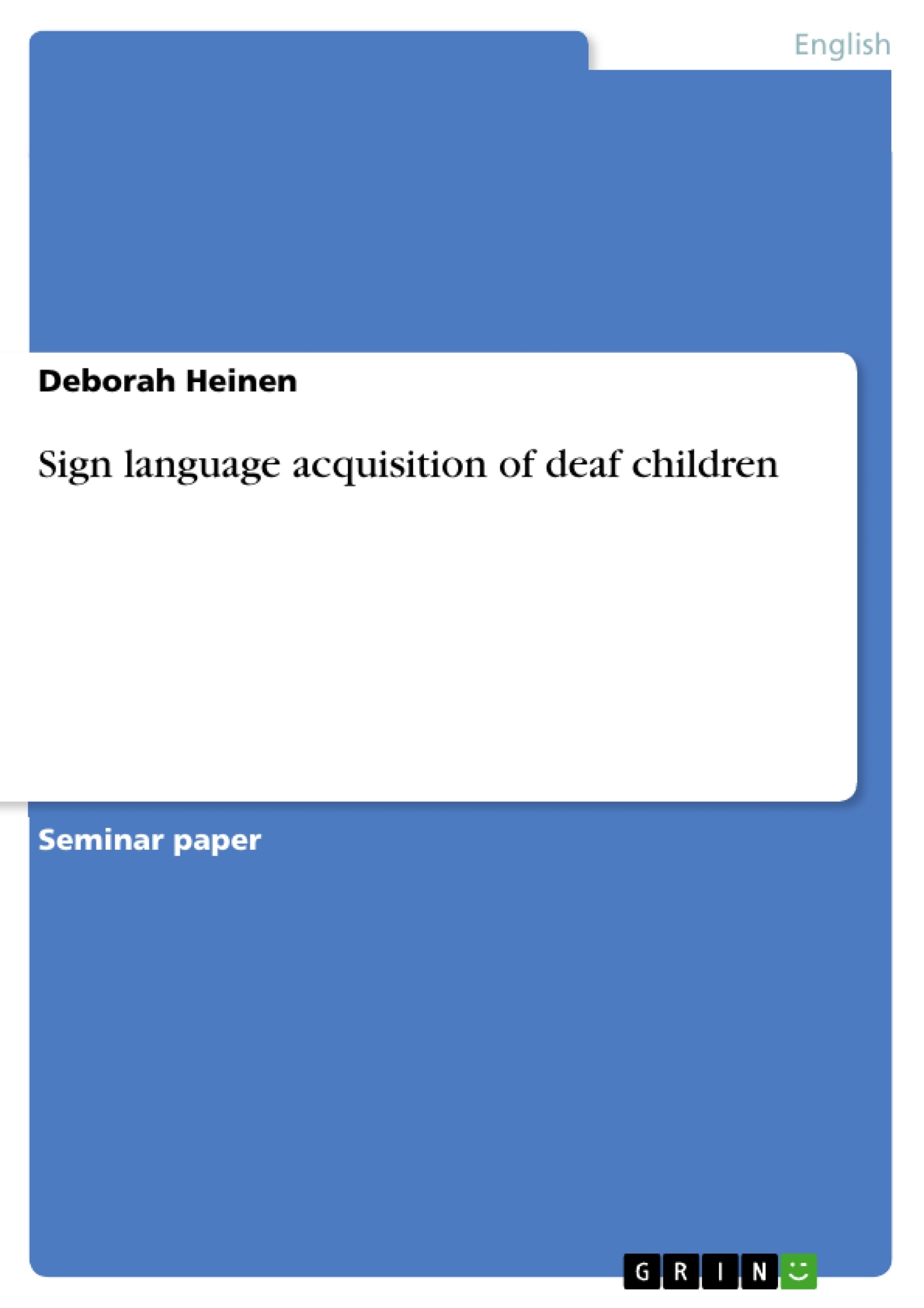Giving a first impression of how the system of sign language works, this term paper starts off with the formal and grammatical structure of American Sign Language. Subsequently, a comparison with the structure of British Sign Language gives insights into similarities and differences between those two sign languages.
In its main part, the term paper focuses on the acquisition of sign language in the deaf child. The development of “speech” is presented chronologically and compared to the linguistic development of hearing children. The vocabulary of hearing and deaf children is compared and different scientific opinions on the issue are being discussed. The last chapter tries to answer the central questions of this term paper: How does the acquisition of sign language differ from language acquisition of hearing children? Are deaf children therefore handicapped? And if yes, to what extent?
Inhaltsverzeichnis (Table of Contents)
- Introduction
- Sign Language as a Language
- A Comparison Between American And British Sign Language
- The Development of Speech in Deaf Children
- The Vocabulary - A Comparison Between Deaf And Hearing Children
Zielsetzung und Themenschwerpunkte (Objectives and Key Themes)
This term paper aims to provide insights into the nature of sign language and its acquisition by deaf children. It examines the linguistic structure of sign language, specifically American Sign Language (ASL), and compares it to British Sign Language (BSL). The paper also explores the development of "speech" in deaf children, comparing it to language acquisition in hearing children. Furthermore, it analyzes the vocabulary of deaf and hearing children and addresses the question of whether deaf children are handicapped in their language acquisition.
- The linguistic structure of sign language
- The acquisition of sign language in deaf children
- A comparison between sign language acquisition and language acquisition in hearing children
- The vocabulary of deaf and hearing children
- The impact of sign language acquisition on the development of deaf children
Zusammenfassung der Kapitel (Chapter Summaries)
- Introduction: This chapter introduces the topic of sign language, emphasizing its complexity and the historical debate surrounding its linguistic status. It outlines the paper's scope and focus, particularly on prelingually deaf children exposed to ASL.
- Sign language as a Language: This chapter explores the linguistic nature of sign language, addressing the historical misconception of its primitiveness. It discusses the work of William Stokoe in establishing ASL as a full-fledged language and examines the modality difference between spoken and signed languages. The chapter also delves into the structure of ASL, highlighting its use of cheremes and parameters like Dez, Tab, and Sig.
- A Comparison Between American And British Sign Language: This chapter provides a comparative analysis of ASL and BSL, highlighting their similarities and differences in structure and grammar. The chapter emphasizes the interesting contrast between the oral English of America and Britain, where spelling varies but grammar remains largely consistent.
- The Development of Speech in Deaf Children: This chapter focuses on the acquisition of sign language by deaf children, presenting a chronological development of "speech." It draws parallels to language acquisition in hearing children and includes a brief discussion of deaf children's attempts at using oral speech. The chapter aims to provide a comprehensive understanding of the process of sign language acquisition in deaf children.
- The Vocabulary - A Comparison Between Deaf And Hearing Children: This chapter explores the vocabulary development of deaf and hearing children, highlighting the differences and similarities in their language acquisition. The chapter acknowledges various perspectives on this topic and sets the stage for further discussion on the impact of sign language acquisition on the development of deaf children.
Schlüsselwörter (Keywords)
This term paper focuses on the key themes of sign language, its linguistic status, and its acquisition by deaf children. It delves into the structure of American Sign Language (ASL), comparing it to British Sign Language (BSL). The paper explores the development of "speech" in deaf children, including their attempts at using oral speech, and examines the vocabulary of deaf and hearing children. Central concepts include cheremes, parameters, modality difference, and the impact of sign language acquisition on the development of deaf children.
- Arbeit zitieren
- Deborah Heinen (Autor:in), 2012, Sign language acquisition of deaf children, München, GRIN Verlag, https://www.grin.com/document/275856



